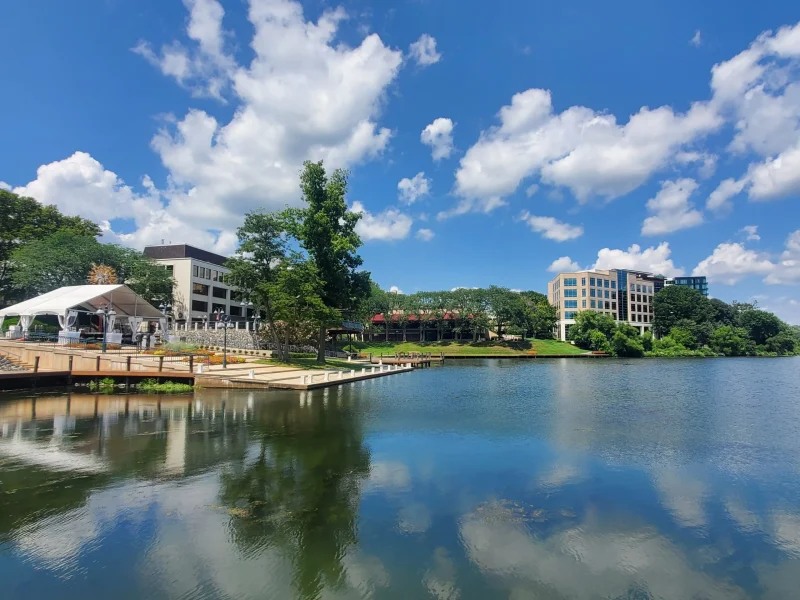The 30 Richest Neighborhoods in Washington State: Elite Communities and Property Values

Washington State’s real estate landscape showcases remarkable wealth concentration across select neighborhoods, with many communities commanding home values well into the millions. The state’s economic prosperity, driven by major technology companies and thriving industries, has created pockets of exceptional affluence throughout the region.
King County dominates the luxury real estate market, hosting the majority of Washington’s most expensive neighborhoods, though wealthy enclaves extend from the Puget Sound region to Spokane and beyond.
These communities reflect diverse geographic settings, from waterfront estates and urban sophistication to suburban tranquility, each offering unique amenities that attract high-income residents and drive property values to extraordinary levels.
Here are the 30 richest neighborhoods in Washington:
1. Hunts Point
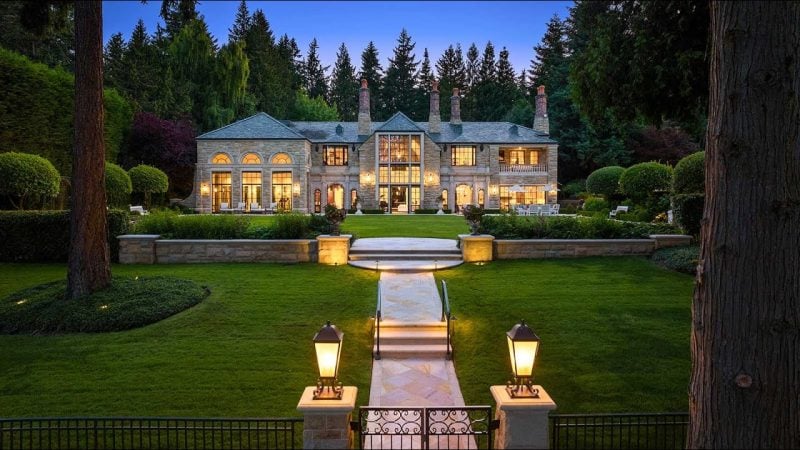
Hunts Point stands as Washington State’s wealthiest community, with an average household income of $620,907 as of 2023. This exclusive lakeside town in King County represents one of the most prestigious addresses in the Pacific Northwest.
The small community maintains a population of just 446 residents across 136 households. Despite its modest size, Hunts Point consistently ranks among the wealthiest neighborhoods in both Washington State and the United States.
The area attracts prominent residents, including tech billionaires and business leaders. Former Amazon CEO Jeff Bezos previously owned property here, selling one mansion for $63 million in March, setting a Washington State residential sales record.
Over 71% of residents hold bachelor’s degrees, reflecting the community’s highly educated population. The unemployment rate remains significantly lower than the state average, contributing to the area’s economic stability and affluence.
2. Medina
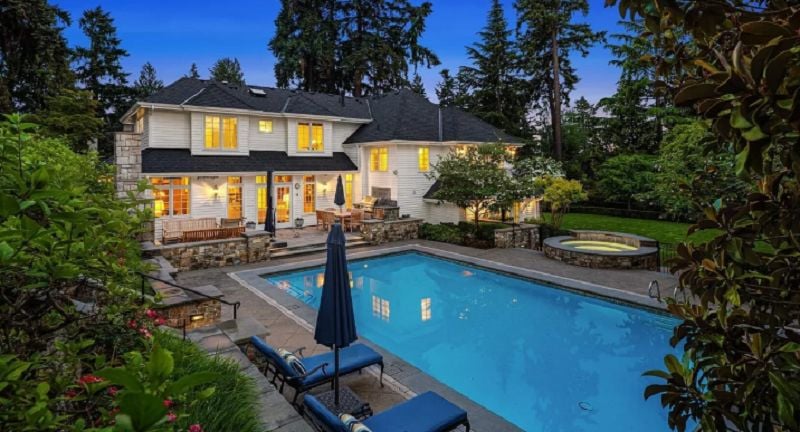
Medina ranks as Washington’s most expensive neighborhood and one of the wealthiest communities in the United States. This Seattle suburb sits on the shores of Lake Washington with a population of approximately 3,200 residents.
The community was incorporated in 1955 and features luxurious waterfront estates with tree-lined streets. Medina’s ZIP code 98039 contains some of the priciest real estate in the country, with average home values exceeding $3 million.
Notable residents include tech billionaires Jeff Bezos and Bill Gates. The neighborhood attracts wealthy families due to its top-rated public schools and family-friendly environment.
Medina offers privacy and prestige while maintaining proximity to Seattle’s business districts. The area is known for its peaceful atmosphere and well-maintained properties that provide stunning views of Lake Washington.
3. Mercer Island
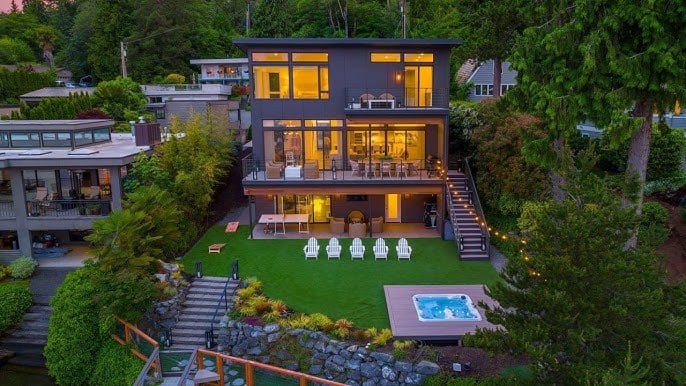
Mercer Island sits in the center of Lake Washington as part of the Seattle metropolitan area. This affluent community consistently ranks among Washington’s wealthiest cities.
The city has a population of approximately 24,700 residents. Median household income reaches $261,547 according to recent data.
Home prices reflect the area’s prosperity. The median home price stands at $2,241,153, with many properties exceeding the million-dollar mark.
Mercer Island operates as both a city and neighborhood within King County. The location provides residents with suburban living while maintaining proximity to Seattle’s urban amenities.
The community attracts wealthy professionals and families seeking upscale residential options. Property values consistently outpace state averages, making it one of Washington’s most expensive real estate markets.
4. Clyde Hill
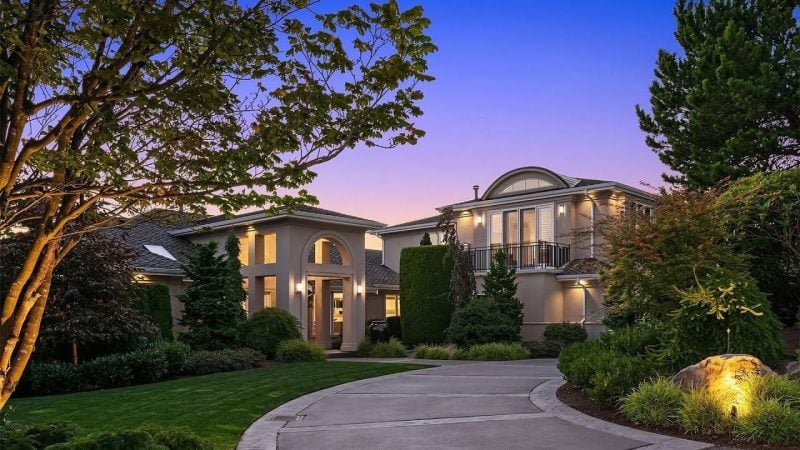
Clyde Hill stands as Washington’s wealthiest community, with a median household income exceeding $409,000. This small city of approximately 3,200 residents is located in King County, east of Seattle.
The community boasts impressive geography with views of Lake Washington, Mount Rainier, and the Olympic Mountains. Home prices reflect this exclusivity, with median values reaching nearly $4 million.
Economic data reveals that 69.1% of households earn over $200,000 annually. This figure exceeds the state average by more than 50 percentage points.
Crime rates consistently fall below national averages, making it attractive for families. The area features notable diversity, with nearly 20% of residents being foreign-born.
Real estate consistently ranks among America’s most expensive markets. The combination of location, views, and proximity to Seattle drives property values significantly above state averages.
5. Sammamish
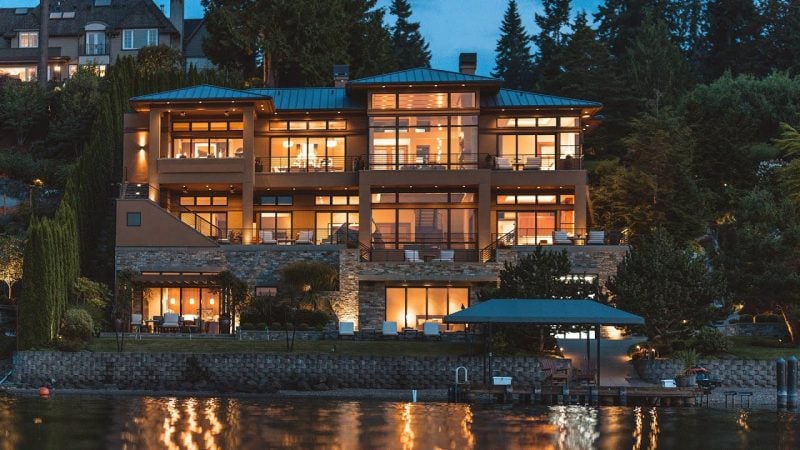
Sammamish ranks as one of Washington’s wealthiest cities, located 20 miles east of Seattle in King County. The city has a population of approximately 67,455 residents.
The median household income in Sammamish reaches $215,047 according to recent data. This places it among the top three richest cities in Washington state.
Home values in Sammamish reflect the area’s affluence, with median home prices around $1,604,612. These prices significantly exceed the state average of $453,663.
The city represents the largest wealthy community by population among Washington’s top 50 wealthiest cities, with 22,258 households. Sammamish consistently appears on lists of the state’s most expensive zip codes.
King County’s dominance in Washington’s luxury real estate market is evident through communities like Sammamish. The area offers residents a quieter alternative to Seattle while maintaining proximity to the metropolitan area.
6. Yarrow Point
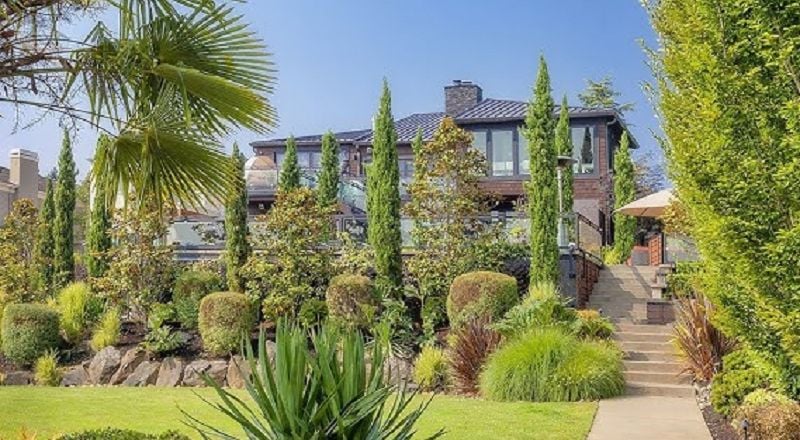
Yarrow Point stands as one of Washington’s most exclusive residential communities. This small peninsula extends into Lake Washington in King County.
The community boasts a median household income of $187,500. Some sources report mean household incomes exceeding $410,000, placing it among the state’s wealthiest areas.
Property values reflect this affluence. The median home price reaches approximately $4.2 million, significantly above Washington’s state average of $453,663.
Yarrow Point spans 231 acres with roughly 405 homes housing about 1,134 residents. The area features luxury waterfront estates and manicured landscapes throughout its 4.32 miles of streets.
This prestigious location offers both privacy and convenience. Residents enjoy a secluded atmosphere while maintaining close proximity to downtown Bellevue and Seattle.
The community consistently ranks among Washington’s safest suburbs with minimal crime rates.
7. Bellevue’s Bridle Trails
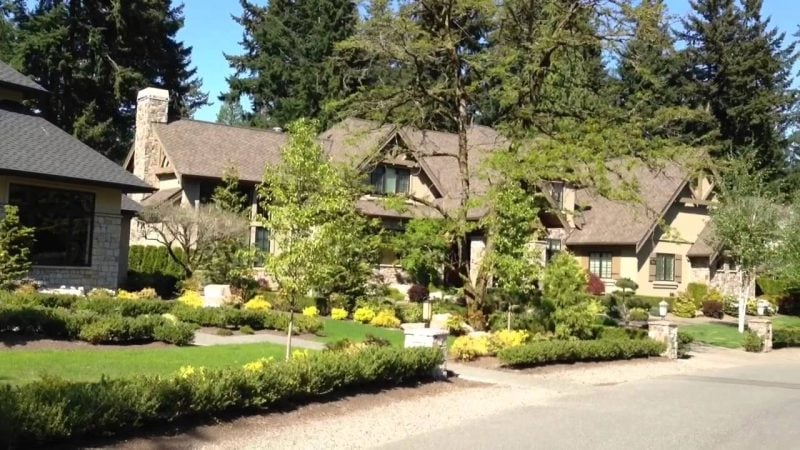
Bridle Trails stands as Bellevue’s premier equestrian community and one of Washington’s most exclusive neighborhoods. This tranquil area features large residential lots, typically exceeding three-quarters of an acre, with many properties designed for horse ownership.
The neighborhood centers around the 482-acre Bridle Trails State Park, which provides 28 miles of equestrian and pedestrian trails. Properties here command premium prices due to their size and unique amenities.
Bridle Trails offers residents a rare combination of rural living and urban convenience. The area sits just five minutes from downtown Bellevue and provides quick access to Highway 520 and Interstate 405.
With a population of 5,432, this heavily wooded community attracts affluent families seeking spacious estates and equestrian facilities. The neighborhood’s large multi-acre properties and proximity to Seattle contribute to its status among Washington’s wealthiest residential areas.
8. Seattle’s Laurelhurst
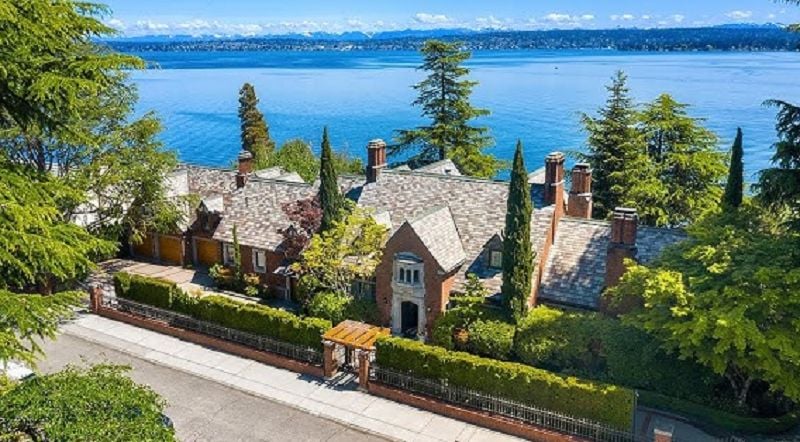
Laurelhurst sits along the shores of Lake Washington in Northeast Seattle. The neighborhood consistently ranks among the city’s wealthiest areas based on property values and household incomes.
The area features stately homes with spectacular lake and mountain views. Tree-lined streets and well-maintained properties create an upscale residential atmosphere.
Laurelhurst offers convenient access to Interstate 5 and the University of Washington. The location provides both privacy and connectivity to Seattle’s urban amenities.
The neighborhood attracts affluent families seeking excellent schools and low crime rates. Strong community ties and family-friendly amenities make it particularly desirable for households with children.
Median home values in Laurelhurst remain among Seattle’s highest. The waterfront location and prestigious reputation contribute to sustained property appreciation in this exclusive enclave.
9. Seattle’s Magnolia
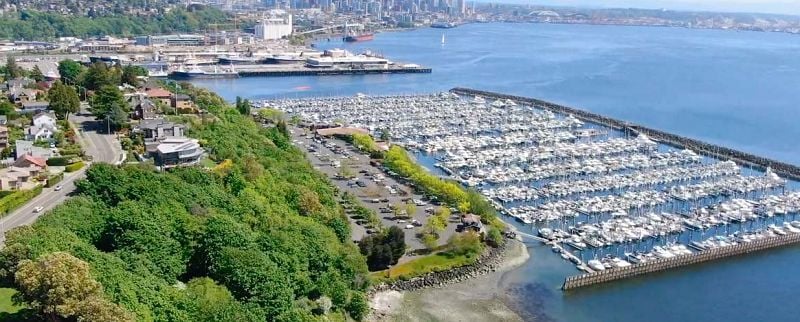
Magnolia stands as one of Seattle’s most affluent neighborhoods with a median household income of $154,831. This places the area in the 96th percentile nationwide for household earnings.
The neighborhood sits among the top 15% highest income areas in America. Education levels contribute significantly to this wealth, with 76% of adults holding bachelor’s degrees or higher compared to 31% nationally.
Located as a residential enclave, Magnolia features a mix of housing types. Single-family homes dominate the interior, while apartments and condos line the neighborhood borders.
The most expensive properties are large estates offering views of Elliott Bay, Puget Sound, and downtown Seattle. These waterfront and view homes command premium prices in the local real estate market.
Magnolia combines urban accessibility with attractive outdoor spaces, making it desirable for affluent residents seeking both convenience and natural beauty.
10. Kirkland’s Houghton
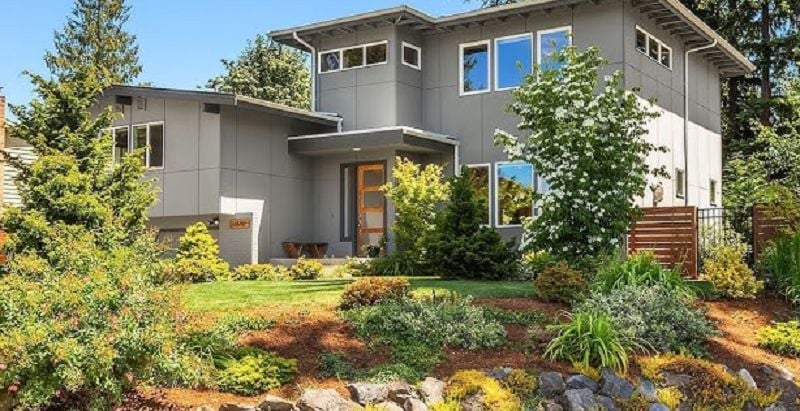
Houghton sits on the northeastern shores of Lake Washington in Kirkland, Washington. The neighborhood occupies prime waterfront real estate with panoramic views across the lake.
Single-family homes in Houghton sell for $1.5 million on average. This price point reflects the area’s desirable location and scenic setting.
The neighborhood borders State Route 520 to the south and Lake Washington to the west. 108th Avenue NE forms another boundary for this well-defined residential area.
Houghton ranks among Kirkland’s most sought-after neighborhoods. The combination of lake access, mountain views, and proximity to major employment centers drives demand.
Rental costs in this area exceed 90.4% of Washington neighborhoods. The high housing costs reflect the premium residents pay for waterfront living and excellent amenities.
11. Kirkland’s Juanita
Kirkland’s Juanita neighborhood ranks among Washington State’s wealthiest residential areas. The median household income reaches $109,300, placing it in the 84th percentile nationally.
This lakeside community attracts affluent residents seeking quality of life near Lake Washington. The neighborhood features significant housing disparity, with property values varying greatly across different sections.
Juanita’s desirable location contributes to its high property values. Residents enjoy proximity to waterfront amenities and Kirkland’s downtown district while maintaining a more residential atmosphere.
The area represents one of Kirkland’s most sought-after neighborhoods. Market demand remains strong due to the combination of scenic location, higher incomes, and established community infrastructure.
Property values reflect the neighborhood’s affluent status. The community continues attracting buyers willing to pay premium prices for Juanita’s combination of location and lifestyle amenities.
12. Edmonds’ Bracketts Landing
Bracketts Landing stands as one of Edmonds’ most prestigious waterfront neighborhoods. The area combines historic significance with modern luxury living.
Properties here command premium prices due to direct water access and stunning views. Residents enjoy panoramic vistas of Puget Sound and the Olympic Mountains.
The neighborhood takes its name from George Brackett, who established the original steamboat pier in 1884. Brackett founded Edmonds and served as its first mayor.
Waterfront homes in this area benefit from proximity to multiple beach parks. The location offers easy access to Brackett’s Landing North and South parks.
Ferry access to the Olympic Peninsula adds convenience for residents. The Edmonds-Kingston ferry terminal sits directly adjacent to the neighborhood.
The underwater park designation enhances the area’s appeal to affluent buyers seeking unique amenities.
13. Redmond’s Grass Lawn
Grass Lawn stands as one of Redmond’s most affluent neighborhoods, with median home prices reaching $669,090 according to recent market data. This figure places the area significantly above the national median of $318,879.
The neighborhood attracts highly educated residents, with 70% of adults holding bachelor’s degrees or higher. This educational achievement far exceeds the national average of 31%.
Rental properties in Grass Lawn command premium prices at $3,869 monthly on average. This rate ranks higher than 90.4% of neighborhoods throughout Washington State.
The area falls within the Lake Washington School District boundaries. Three elementary schools serve the neighborhood: Rose Hill Elementary, Franklin Elementary, and Rush Elementary.
Grass Lawn’s location in Redmond provides residents access to the broader Eastside economy while maintaining neighborhood character. The area represents one of the more expensive housing markets in the region.
14. Issaquah Highlands
Issaquah Highlands stands as one of Washington’s most affluent neighborhoods with a median household income of $181,590. This places the community in the 98th percentile nationally for household income.
The neighborhood’s wealth correlates strongly with high education levels. About 83% of adults hold bachelor’s degrees or higher, compared to just 31% nationwide.
Housing costs reflect the area’s prosperity, with median home prices reaching $849,212. This significantly exceeds the national median of $318,879.
The community was designed as a planned urban village with built-green principles. Its deliberate development distinguishes it from typical suburban areas.
Issaquah Highlands benefits from its location in King County, which dominates Washington’s high-end real estate market. The neighborhood attracts affluent residents seeking quality amenities and educational opportunities.
15. Seattle’s Queen Anne
Queen Anne ranks among Seattle’s wealthiest neighborhoods, situated northwest of downtown on the city’s highest-named hill at 139 meters elevation. The area attracts Seattle’s economic and cultural elite who construct luxury homes on its elevated terrain.
The neighborhood reports a median household income of $140,192, placing it in the 93rd percentile nationally. This income level significantly exceeds the U.S. median, reflecting the area’s affluent resident base.
Education levels correlate strongly with the high incomes. About 74% of Queen Anne adults hold bachelor’s degrees or higher, compared to just 31% nationwide.
The hillside location provides residents with stunning views and proximity to downtown Seattle. Queen Anne combines urban convenience with exclusive residential appeal, making it a preferred choice for wealthy professionals and entrepreneurs in the tech-driven Seattle economy.
16. Seattle’s Capitol Hill
Capitol Hill stands as one of Seattle’s most affluent neighborhoods with a median household income of $104,010. This places the area in the 81st percentile nationally, well above the United States median income.
The neighborhood’s prosperity stems largely from its highly educated population. Approximately 76% of Capitol Hill residents hold bachelor’s degrees or higher, compared to just 31% nationwide.
Education levels typically correlate with higher earning potential, which explains the area’s elevated income statistics. The neighborhood attracts young professionals and creative workers who value its urban lifestyle.
Capitol Hill combines residential wealth with cultural vibrancy. The area offers proximity to downtown Seattle while maintaining its distinct character as an arts and entertainment district.
The neighborhood’s real estate values reflect its desirability among Seattle’s affluent residents. Its strategic location and educated demographic contribute to its status among Washington State’s wealthiest communities.
17. Kenmore
Kenmore ranks as one of Washington’s affluent communities, situated in King County just north of Seattle. The city attracts residents seeking premium real estate options and higher quality of life standards.
Housing types in Kenmore include single-family homes, low-rise condominiums, townhomes, and rental apartments. The neighborhood quality varies significantly throughout the city, creating distinct pockets of wealth and value.
Market data shows Kenmore’s best neighborhoods command higher median home values, reflecting strong buyer demand. These areas typically feature lower crime rates and superior amenities that justify premium pricing.
The city’s proximity to Seattle enhances its appeal among high-income professionals. King County’s dominance in Washington’s luxury real estate market extends to Kenmore’s most desirable residential areas.
Real estate appreciation patterns in Kenmore demonstrate consistent growth over multiple years. The market reflects broader trends seen across Washington’s wealthiest communities, with sustained demand driving property values upward.
18. Woodinville
Woodinville ranks among Washington’s wealthiest communities, consistently appearing on lists of the state’s most affluent zip codes. The city’s median household income significantly exceeds both state and national averages.
Home prices in Woodinville cost much more than Washington’s average of $453,663. The strong correlation between wealth and housing costs is evident throughout the area.
Located east of Seattle in the Puget Sound region, Woodinville joins other wealthy eastside communities like Sammamish and Redmond. This geographic clustering reflects the area’s economic prosperity.
The community offers a mix of luxury estates, equestrian properties, and custom-built homes nestled in wooded settings. Highly rated schools and quiet neighborhoods contribute to its desirability among affluent families.
Woodinville maintains its reputation as both a residential haven and weekend destination, attracting residents who value rural charm combined with proximity to Seattle’s employment centers.
19. Bothell’s North Creek
North Creek stands as one of Washington’s most affluent neighborhoods with a median household income of $113,855. This places the community in the 90th percentile nationally for household earnings.
The neighborhood benefits from high educational attainment rates. Nearly 47% of adults hold bachelor’s degrees or higher, significantly exceeding the national average of 31%.
North Creek features modern single-family homes and upscale townhomes on large lots. The area emphasizes newer construction and quality development standards.
Interstate 405 bisects the neighborhood, providing convenient freeway access to Seattle and surrounding areas. Public transportation connects residents to major regional cities through multiple bus routes.
The University of Washington-Bothell campus sits on the neighborhood’s west side. Its transit center serves as a hub for regional transportation connections.
Home values in North Creek align with Bothell’s average of $610,738, reflecting the area’s desirable market position.
20. Renton’s Kennydale
Kennydale sits along the southeastern shore of Lake Washington in Renton, Washington. The neighborhood has approximately 4,840 residents and straddles Interstate 405 between Renton and Bellevue.
The median household income in Kennydale reaches $113,598. This places the neighborhood in the 86th percentile for household incomes across the United States.
Kennydale offers stunning views of Lake Washington and the Olympic Mountains. The area provides residents with waterfront access and scenic natural surroundings.
The neighborhood borders Newport Shores in Bellevue, connecting it to other affluent areas. Interstate 405 runs directly through Kennydale, providing convenient access to major employment centers.
Kennydale has become one of Renton’s most desirable residential areas. The combination of lakefront location, higher incomes, and proximity to Bellevue contributes to its status among Washington’s wealthier neighborhoods.
21. Lake Forest Park
Lake Forest Park ranks among Washington’s most affluent communities with a median household income of $138,043. This figure significantly exceeds the national median of $67,500.
The city maintains an exceptionally low poverty rate of just 3%. Only 11% of households earn less than $50,000 annually, compared to 39% nationally.
Located eight miles north of Seattle, Lake Forest Park provides direct access to major economic centers. Residents can easily reach Redmond, Bellevue, and Everett.
The community places in the top tenth percentile of Washington’s wealthiest neighborhoods. Home prices consistently rank among the most expensive in both the state and nation.
Lake Forest Park houses approximately 13,000 residents across four distinct neighborhoods. The City Center neighborhood particularly stands out, with income levels higher than 97.6% of American neighborhoods.
22. Bainbridge Island’s Winslow
Winslow serves as the downtown district and historic heart of Bainbridge Island. This waterfront community spans approximately 1.5 square miles overlooking Eagle Harbor.
Named after shipbuilder Winslow Hall, the area was incorporated as a city in 1947. Today it functions as the island’s primary town center and commercial hub.
The neighborhood centers around Winslow Way, the main street lined with shops and restaurants. Residents enjoy walkable streets and small-town atmosphere while maintaining proximity to Seattle via ferry service.
Bainbridge Island ranks among Washington’s wealthiest cities. The island’s affluent status extends to Winslow, where waterfront properties and historic homes command premium prices.
The area attracts high-income professionals who commute to Seattle. Ferry access to downtown Seattle takes approximately 35 minutes, making it popular with urban workers seeking island living.
23. Shoreline
Shoreline sits in King County, just north of Seattle. The city attracts affluent residents with its strategic location and quality neighborhoods.
The median household income in Shoreline reaches $103,128. This places the city in the 92nd percentile nationally for household incomes.
Education levels contribute significantly to the area’s wealth. About 50% of adults hold bachelor’s degrees or higher, compared to 31% nationwide.
Home values in Shoreline exceed Washington’s state average of $453,663. The local real estate market reflects strong demand from professionals seeking proximity to Seattle.
The city primarily features single-family homes, townhomes, and low-rise condominiums. These housing types appeal to families and professionals working in the greater Seattle area.
Shoreline’s combination of high incomes, educated residents, and premium real estate prices establishes it among Washington’s wealthiest communities.
24. Mukilteo
Mukilteo stands out as one of Washington’s affluent communities, with home values significantly exceeding the state average. The city’s real estate market commands premium prices compared to other Washington cities with similar populations.
Located in Snohomish County, Mukilteo offers waterfront living with ferry access to Whidbey Island. The community attracts high-income residents seeking scenic views and proximity to major employment centers.
Home prices in Mukilteo surpass Washington’s state average of $453,663. The city’s desirable location along Puget Sound contributes to its elevated property values and affluent resident base.
Mukilteo’s neighborhoods feature strong investment potential due to their scenic waterfront locations and established community amenities. The city maintains its appeal through quality schools and convenient transportation access to Seattle and surrounding areas.
25. Burien’s Highline
Burien’s Highline neighborhood represents a well-established residential area in King County’s southern region. The community sits strategically between Seattle and Tacoma, offering residents convenient access to both metropolitan areas.
The median household income in Highline reaches $58,600, with the 95th percentile earning $159,000 annually. These figures place the neighborhood among Washington’s more affluent communities outside the immediate Seattle core.
Highline attracts families and professionals seeking suburban living with urban accessibility. The area features established housing stock and mature landscaping that appeals to long-term residents.
The neighborhood benefits from proximity to Seattle-Tacoma International Airport and major transportation corridors. This location advantage supports both residential appeal and property values in the local market.
Highline’s demographic profile shows stability with moderate population growth over recent years.
26. Federal Way’s Dash Point
Dash Point stands as one of Federal Way’s most desirable neighborhoods, offering residents premium waterfront living along Puget Sound. The area features stunning views of the Olympic Mountains and direct access to miles of pristine beaches.
Property values in Dash Point reflect its prime location and natural amenities. The neighborhood attracts affluent buyers seeking scenic waterfront homes with modern conveniences.
Dash Point State Park provides residents with exclusive access to hiking trails and beach recreation. The area maintains a family-friendly atmosphere with top-rated schools nearby.
The neighborhood consists primarily of single-family homes and upscale condominiums. Many properties feature water views and private beach access, commanding premium prices in the Federal Way market.
Dash Point’s proximity to major highways provides easy commuting access to Seattle and Tacoma. This combination of natural beauty and urban accessibility makes it a sought-after location for wealthy residents.
27. Lynnwood
Lynnwood represents a growing wealth center in Washington’s competitive real estate market. The city features significant housing disparity, with neighborhood quality varying considerably across different areas.
Lynn Crest stands as the most expensive neighborhood in Lynnwood. This area commands a median home price of $1,025,821 with median rents reaching $1,686.
The neighborhood has experienced the strongest home price growth over the past three years. This performance ranks Lynn Crest first among all Lynnwood neighborhoods for appreciation.
Lynnwood’s housing market maintains relatively stable prices with consistent upward movement. The city attracts families seeking peaceful, convenient lifestyles in well-established communities.
Alderwood Manor serves as another notable family-friendly neighborhood within Lynnwood. The area benefits from the city’s connection to the highly-ranked Edmonds Public School District.
The district ranks in the top 25 statewide and serves approximately 20,000 students. This educational strength supports sustained property values throughout Lynnwood’s residential areas.
28. Spokane’s South Hill
South Hill stands as one of Spokane’s most desirable neighborhoods, combining historic charm with modern amenities. The area features higher median household incomes compared to many other Spokane neighborhoods.
This established community blends traditional and contemporary architecture. Many homes sit on tree-lined streets with mature landscaping and spacious lots.
The neighborhood offers abundant parks and walking trails throughout the area. Residents enjoy easy access to local businesses and dining options within the community.
South Hill’s location provides convenient access to downtown Spokane while maintaining a suburban atmosphere. The area attracts families and professionals seeking quality housing in a well-established setting.
Real estate prices reflect the neighborhood’s desirability and prime location. The community maintains strong property values due to its reputation and amenities.
29. Bellingham’s Fairhaven
Fairhaven ranks as Bellingham’s most expensive neighborhood with a median home price of $614,770. The historic waterfront district commands $751 per square foot for residential properties.
Located on Bellingham’s southern edge, Fairhaven combines 19th-century charm with modern amenities. The neighborhood features walkable streets lined with boutique shops, restaurants, and cafes.
The area has experienced significant property value growth over the past three years. This appreciation places Fairhaven at the top of Bellingham’s real estate market.
Residents enjoy access to the Fairhaven Village Green, which hosts concerts, farmers markets, and community events. The South Bay Trail connects the neighborhood to downtown Bellingham and surrounding recreational areas.
The district’s proximity to the waterfront and ferry terminal adds to its appeal. Historic architecture and preserved buildings contribute to the neighborhood’s premium real estate values.
30. Richland’s Columbia Park
Richland’s Columbia Park neighborhood represents one of the Tri-Cities’ most desirable residential areas. The community sits along the Columbia River, offering residents scenic waterfront access and premium location benefits.
This neighborhood attracts affluent families seeking riverside living in Washington’s southeastern region. Properties near the Columbia River command higher prices due to their proximity to recreational amenities and scenic views.
The area features well-maintained homes with access to Columbia Park’s extensive trail systems and green spaces. Many residences offer direct river access or short walking distances to waterfront recreational facilities.
Columbia Park’s location provides residents with both natural beauty and urban convenience. The neighborhood benefits from Richland’s growing economy while maintaining a peaceful residential atmosphere along the river corridor.
Factors That Influence Neighborhood Wealth
Several key elements shape the wealth concentration in Washington’s most affluent neighborhoods. Property values, educational quality, and economic opportunities work together to create and maintain these high-income communities.
Real Estate Market Trends
Washington’s luxury real estate market has experienced extraordinary growth over the past 15 years. King County dominates the high-end landscape with neighborhoods like Medina, where ZIP code 98039 represents some of the priciest real estate in the country.
Waterfront properties command premium prices throughout the state. Areas near Puget Sound and Lake Washington consistently maintain higher property values due to their scenic locations and limited supply.
Market trends show wealthy neighborhoods clustering around major metropolitan areas. Seattle’s surrounding communities benefit from proximity to the city while offering more space and privacy.
Key price drivers include:
- Waterfront access
- Proximity to Seattle
- Limited housing inventory
- Geographic barriers that restrict development
Education and School Districts
Top-performing school districts significantly impact neighborhood wealth levels. Families with higher incomes often choose locations based on educational quality, driving up property values in these areas.
Districts serving wealthy communities typically receive more funding through property taxes. This creates a cycle where better schools attract affluent families, increasing property values and generating more tax revenue.
Private school access also influences neighborhood desirability. Areas with proximity to prestigious private institutions tend to attract wealthy families seeking educational options.
Educational factors affecting wealth:
- Test scores and graduation rates
- College preparation programs
- Extracurricular offerings
- Teacher-to-student ratios
Industry and Employment Opportunities
Washington’s tech industry concentration creates wealth clusters around major employers. Areas near Microsoft, Amazon, and other tech giants attract high-earning professionals who can afford premium housing.
The state’s diverse economy supports various high-income sectors. Aerospace, biotechnology, and financial services provide employment opportunities that sustain wealthy neighborhoods.
Proximity to business centers influences neighborhood wealth levels. Communities with shorter commutes to major employment hubs typically maintain higher property values and resident incomes.
Remote work trends have expanded the geographic reach of high-paying jobs. Some previously modest areas now attract wealthy professionals who no longer need daily office access.
Economic Impact on Local Communities
Wealthy neighborhoods in Washington State generate substantial economic benefits through enhanced tax revenues that fund superior public services and infrastructure. These communities also foster robust philanthropic networks that support both local and statewide initiatives.
Public Services and Infrastructure
High-income neighborhoods contribute significantly higher property tax revenues compared to average communities. Areas like Hunts Point and Medina generate tax bases that fund enhanced police services, fire departments, and emergency response systems.
These neighborhoods typically maintain superior road conditions and advanced utility infrastructure. Property values in wealthy areas often exceed $2 million, creating substantial tax revenue streams for local governments.
Key Infrastructure Benefits:
- Advanced telecommunications networks
- Well-maintained parks and recreational facilities
- Modern water and sewer systems
- Enhanced street lighting and landscaping
The economic spillover effects extend beyond neighborhood boundaries. Local governments use excess revenue from wealthy areas to support infrastructure improvements in adjacent communities.
School districts benefit substantially from high property values in affluent neighborhoods. These areas often fund educational programs and facilities that serve broader regional populations.
Community Organizations and Philanthropy
Wealthy neighborhoods in Washington State support extensive charitable giving networks. Residents in areas like Bellevue and Sammamish contribute significantly to local nonprofits and community development organizations.
Private foundations established by affluent residents fund scholarships, healthcare initiatives, and arts programs. These contributions often exceed millions of dollars annually within individual communities.
Primary Philanthropic Focus Areas:
- Education and youth programs
- Healthcare and medical research
- Environmental conservation
- Arts and cultural institutions
Local business districts benefit from wealthy residents’ consumer spending patterns. High-end retail establishments and professional services cluster in these areas, creating employment opportunities for surrounding communities.
Community organizations receive both financial support and volunteer leadership from affluent residents. This combination of resources and expertise helps sustain long-term community development projects throughout Washington State.
